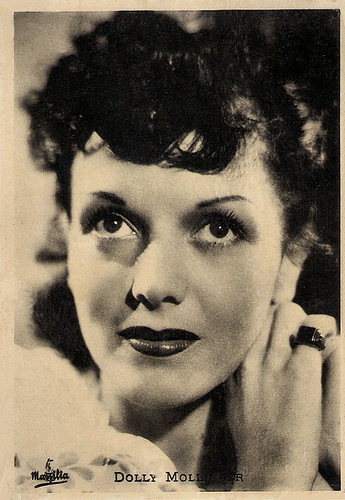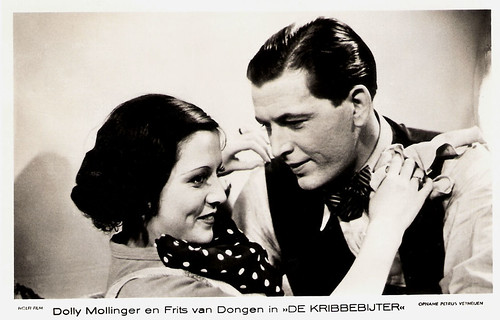Every year in early autumn, the Netherlands Film Festival (NFF) takes place. For ten days, the city of Utrecht is the cinema capital of the Netherlands, and we join the fun with our own Unofficial Dutch Film Star Postcards Festival (UDFSPF). Today, we feature beautiful Dolly Mollinger (1911-2004), who gained stardom in the 1930s. But whatever happened to the girl who was once called 'Netherlands’s most beloved secretary'?

French collector card by Massilia.
Dolly Mollinger was born Margot Frédérique Amélie Eugénie Mollinger in Amsterdam, The Netherlands, in 1911. She was the daughter of Theodore Godefroi Mollinger and Petronella Theodora Maters. Theodore Godefroi was a chemist and later deputy director of a dairy.
Dolly made her film debut opposite Cor Ruys and Frits van Dongen (a.k.a. Philip Dorn) in the comedy De Kribbebijter / The Cross-Patch (1935), which was directed by German director Hermann Kosterlitz and Ernst Winar.
It was remarkable that Mollinger got this leading role. She was working as a secretary at film distributor Universal at the time and did not have any experience as an actress. Director Hermann Kosterlitz preferred the beautiful secretary above Mary Dresselhuys and Lily Bouwmeester, two actresses who were well known.
Kosterlitz was probably right because the film was a success both among the critics and the public. A year later, Kosterlitz moved to Hollywood, where he directed under the name Henry Koster many box office hits, starting with Deanna Durbin’s first film, Three Smart Girls (1936).
After Dolly Mollinger’s success in De Kribbebijter followed supporting roles in the Dutch films Het leven is niet zo kwaad / Life is Not So Bad (Haro van Peski, 1935), starring Lou Bandy, and the tempestuous tropical romance Rubber (Johan de Meester, Gerard Rutten, 1936), filmed on Sumatra, now part of Indonesia. Then, Mollinger played the female lead in the Dutch-French coproduction De man zonder hart / The Man Without a Heart (Léo Joannon, Louis de Bree, 1937), filmed in Paris.

Dutch postcard by M. B.. & Z. Photo: Holfi Film / Petrus Verheijen. Publicity still for De Kribbebijter / The Cross-Patch (Hermann Kosterlitz a.k.a. Henry Koster, 1935) with Frits van Dongen.
Dolly Mollinger continued her career abroad. In Great Britain, she appeared with Charles Laughton and Elsa Lanchester in Vessel of Wrath / The Beachcomber (Bartlett Cormack, Erich Pommer, 1938). Dutch newspapers reported that Mollinger was offered a Hollywood contract for five years by film producer and talent agent Myron Selznick.
However, in the following years, she starred in two French films, Altitude 3,200 (Jean Benoît-Lévy, Marie Epstein, 1938) with Jean-Louis Barrault, and her final film, Place de la Concorde (Carl Lamac, 1939) with Albert Préjean. Then the war broke off her budding film career.
Little is known about what happened with Dolly Mollinger during the war and later. Below, I made a compilation of the snippets of information I found in Dutch newspaper articles and other sources.
In the Netherlands, ‘Europe’s most beautiful secretary’ remained a sweet memory for some men. In 1958, J.W.A. Lefeber registered a beautiful narcissus in white and yellow, named ‘Dolly Mollinger’. Nowadays, this narcissus is better known than the former actress. Dolly Mollinger died in Port Orchard, U.S.A., in 2004, a few months before her 93rd birthday.

Dutch film poster for De kribbebijter (1935). Design: Frans Mettes.

Narcissus Dolly Mollinger. Source: Jindrich Shejbal @ Flickr.
Sources: Delpher (Dutch), AllMovie, Daffseek.org, Wikipedia (Dutch and French) and IMDb.
This post was last updated on 14 October 2025.

French collector card by Massilia.
A remarkable debut
Dolly Mollinger was born Margot Frédérique Amélie Eugénie Mollinger in Amsterdam, The Netherlands, in 1911. She was the daughter of Theodore Godefroi Mollinger and Petronella Theodora Maters. Theodore Godefroi was a chemist and later deputy director of a dairy.
Dolly made her film debut opposite Cor Ruys and Frits van Dongen (a.k.a. Philip Dorn) in the comedy De Kribbebijter / The Cross-Patch (1935), which was directed by German director Hermann Kosterlitz and Ernst Winar.
It was remarkable that Mollinger got this leading role. She was working as a secretary at film distributor Universal at the time and did not have any experience as an actress. Director Hermann Kosterlitz preferred the beautiful secretary above Mary Dresselhuys and Lily Bouwmeester, two actresses who were well known.
Kosterlitz was probably right because the film was a success both among the critics and the public. A year later, Kosterlitz moved to Hollywood, where he directed under the name Henry Koster many box office hits, starting with Deanna Durbin’s first film, Three Smart Girls (1936).
After Dolly Mollinger’s success in De Kribbebijter followed supporting roles in the Dutch films Het leven is niet zo kwaad / Life is Not So Bad (Haro van Peski, 1935), starring Lou Bandy, and the tempestuous tropical romance Rubber (Johan de Meester, Gerard Rutten, 1936), filmed on Sumatra, now part of Indonesia. Then, Mollinger played the female lead in the Dutch-French coproduction De man zonder hart / The Man Without a Heart (Léo Joannon, Louis de Bree, 1937), filmed in Paris.

Dutch postcard by M. B.. & Z. Photo: Holfi Film / Petrus Verheijen. Publicity still for De Kribbebijter / The Cross-Patch (Hermann Kosterlitz a.k.a. Henry Koster, 1935) with Frits van Dongen.
A beautiful narcissus
Dolly Mollinger continued her career abroad. In Great Britain, she appeared with Charles Laughton and Elsa Lanchester in Vessel of Wrath / The Beachcomber (Bartlett Cormack, Erich Pommer, 1938). Dutch newspapers reported that Mollinger was offered a Hollywood contract for five years by film producer and talent agent Myron Selznick.
However, in the following years, she starred in two French films, Altitude 3,200 (Jean Benoît-Lévy, Marie Epstein, 1938) with Jean-Louis Barrault, and her final film, Place de la Concorde (Carl Lamac, 1939) with Albert Préjean. Then the war broke off her budding film career.
Little is known about what happened with Dolly Mollinger during the war and later. Below, I made a compilation of the snippets of information I found in Dutch newspaper articles and other sources.
- When the war started, Dolly fled from Paris to Brittany.
- In 1939, she married German screenwriter Walter Schlee.
- In 1940, she was back in the Netherlands and announced she would appear in a Dutch variety show. Whether she really appeared on the Dutch stages is unclear.
- In 1943, the ANP correspondent in Berlin reported that after her work in France, she had got a Ufa contract. However, there are no German films with her known.
- In 1943, she was writing a script, the ANP correspondent added. IMDb does indeed confirm that she wrote the scenario for the German film Komm zu mir zurück / Come Back to Me (Heinz Paul, 1944). This is her last film credit in the database.
- According to Wikipedia, Mollinger moved to the United States, but she had no luck in Hollywood. She worked in the U.S. as a school teacher.
- In 1952, Mollinger remarried to Gerhard Kimpel, an American citizen.
In the Netherlands, ‘Europe’s most beautiful secretary’ remained a sweet memory for some men. In 1958, J.W.A. Lefeber registered a beautiful narcissus in white and yellow, named ‘Dolly Mollinger’. Nowadays, this narcissus is better known than the former actress. Dolly Mollinger died in Port Orchard, U.S.A., in 2004, a few months before her 93rd birthday.

Dutch film poster for De kribbebijter (1935). Design: Frans Mettes.

Narcissus Dolly Mollinger. Source: Jindrich Shejbal @ Flickr.
Sources: Delpher (Dutch), AllMovie, Daffseek.org, Wikipedia (Dutch and French) and IMDb.
This post was last updated on 14 October 2025.
No comments:
Post a Comment